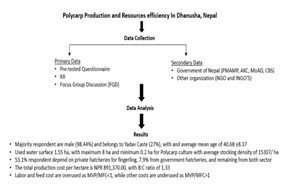Exploring economic viability: A study on profitability and resource efficiency in Polycarp production within the fish super zone of Dhanusha district, Nepal
Abstract
Dhanusha district of Nepal is recognized as a fish hub of the country still operative fish farming in a semi-commercial level. This study evaluated and analyzed the profitability and resources utilization efficiency in the Polycarp production within the fish super zone of Dhanusha district. Along with it, the study covers socio-demographic characteristic of respondent, determine the factor affecting fish production, rank such challenges based on farmer’s experience, and evaluate returns to scale fish production of this site. 64 farmers were randomly selected and surveyed through a semi-structured questionnaire. In order to collect primary data, pre-tested interview schedule, focus group discussion, key informant Interview, and field survey were conducted. Secondary data were collected by reviewing relevant publications. Analysis of socio-demographic data revealed a predominantly male participation rate (98.44%), with overall aged between 30 and 50 years, among whom the Yadav caste showed maximum engagement (27%). Regarding land ownership, the majority (68.76%) leased land for this activity. Carp polyculture exhibited an average water surface area of 1.55 hectares. The average yearly cost of producing carp fish was Rs.1069644.00, or Rs. 891370.00 per hectare of water surface, per year with fixed costs 15.55% and variable costs 84.45%. Notably, feed costs constituted the largest expense at 49.87%, followed by labor (15.52%) and fingerlings (9.40%). Silver carp emerged as the primary market contributor, comprising 22.96% of total production (6010 kg), followed by common carp, Grass carp, Rohu, Naini, Bighead carp, and Bhakur. Net returns per hectare was Rs. 2,24,348.87, with a resulting B:C ratio of 1.33, indicating economic viability. Challenges identified in the study area included the timely unavailability of fingerling, high feed cost and theft.
Keywords:
Aquaculture, Carps, Dhanusha, Economic, MarketingDownloads
References
Casey, E., & O’Brien, D. (2020). Sociology, sociology and the cultural and creative industries. Sociology, 54(3), 443-459.
CBS. (2015). Compendium-of-Environment-Statistics-Nepal-2015. Central Bureau of Statistics. https://cbs.gov.np/wp-content/upLoads/2018/12/Compendium-of-Environment-Statistics-Nepal-2015.pdf
CBS. (2021). Preliminary Data of National Population and Housing Census 2021. Retrieved from https://censusnepal.cbs.gov.np/results
CFPCC. (2021). Statistical Information on Nepalese Agriculture 2076/77. Retrieved from https://moald.gov.np/wp-content/uploads/2022/04/statistical-information-on-nepalese-agriculture-2076-77-2019-20.pdf
Banmali P, Devkota, M., Kathayat, H., & Win, A. M., (2021). Enhancing the Production of Carp Polyculture and Tilapia by Integrating with Duck Farming in Nepal”- Aquaculture for Small Scale Farmers and Sustainability. Global Journal of Science Frontier Research, 21(C2), 15–24. Retrieved from https://journalofscience.org/index.php/GJSFR/article/view/101802
Dhakal, S. C., Regmi, P. P., Thapa, R. B., Sah, S. K., & Khatri-Chhetri, D. B. (2015). Profitability and resource use efficiency of buckwheat (Fagopyrum esculentum Moench) production in Chitwan District, Nepal. Journal of Agriculture and Environment, 16, 120–131. https://doi.org/10.3126/aej.v16i0.19845
Goni, M., Umar, A. S. S., & Usman, S. (2013). Analysis of Resource-Use Efficiency in Dry Season Vegetable Production in Jere, Borno State, Nigeria. Journal of Biology, Agriculture and Healthcare, 3(19), 18. https://www.iiste.org/Journals/index.php/JBAH/article/view/9770
Gupta, V. K. (2007). Perspectives in animal ecology and reproduction (Vol. 4). Daya Books. Retrieved from https://books.google.com/books/about/Perspectives_in_Animal_Ecology_and_Repro.html?id=6dRzerpqnOEC
Jhingam M. L., (1997). Microeconomic Theory, 12th Revised & Enlarged Edition (2010), Vrinda publication, Delhi. Retrieved from https://www.academia.edu/112769354/Macro_Economic_Theory_by_ML_Jhingan
Kathayat H., & Minh Tam, B. (2021). Effects of Ovaprim on Spawning Induction and Larval Rearing of Tire Track Eel (Mastacembelus Favus)", International Journal of Science and Research (IJSR), Volume 10 Issue 9, September 2021, pp. 1094-1102. https://www.ijsr.net/archive/v10i9/SR21920090527.pdf
Kathayat, H., Devkota, M. K., Banmali, P., & Shrestha, N. (2021). Carp-tilapia polyculture integration with pigs- enhancing benefits to uplift the economic status of small scaled farmers of Nepal. International Journal of Fisheries and Aquatic Studies, 9(4):07-14 https://www.fisheriesjournal.com/archives/2021/vol9issue4/PartA/9-3-32-334.pdf
Kunwar, P. S., & Adhikari, B. (2016). Status and development trend of aquaculture and fisheries in Nepal. Nepalese Journal of Aquaculture and Fisheries, 3, 1-11.
MoALD. (2022). Progress Report-2022. https://moald.gov.np/publication-types/progress-report/
MoALD. (2022). Statistical Information on Nepalese Agriculture 2077/78. https://moald.gov.np/wp-content/uploads/2022/07/statistical-information-on-nepalese-agriculture-2077-78.pdf
Okeoghene, E. S. (2013). Assessment of the marketing of frozen fish (iced fish) in Edo State, Nigeria. Asian Journal of Business Management, 5(4), 353-357. https://maxwellsci.com/print/ajbm/v5-353-357.pdf
Scheaffer, R. L., Mendenhall, W., Ott, L., & Gerow, K. (1990). Elementary survey sampling (Vol. 501). Belmont, CA, USA: Duxbury Press.
Shrestha, S. P., Bajracharya, P., Rayamajhi, A., & Shrestha, S. P. (2019). Study on Status of Fish Diseases in Nepal. Nepalese Veterinary Journal, 36, 30–37. https://doi.org/10.3126/nvj.v36i0.27750
Shrestha, T.K. (2019). Ichthyology of Nepal: a study of fishes of the Himalayan waters. Publisher- Himalayan Ecosphere, 2008 https://www.semanticscholar.org/paper/Ichthyology-of-Nepal-%3A-a-study-of-fishes-of-the-Shrestha/60fc89c54e7bae5054922a45f3ab12083fcac5ec
Whelton, P. K. (2017). High Blood Pressure |American Heart Association. https://www.heart.org/en/health-topics/high-blood-pressure
Yamane, T. (1973). Statistics. An introductory analysis (3rd ed.). https://www.scirp.org/reference/ReferencesPapers?ReferenceID=1655260

Published
How to Cite
Issue
Section
Copyright (c) 2024 Agriculture and Environmental Science Academy

This work is licensed under a Creative Commons Attribution-NonCommercial 4.0 International License.

